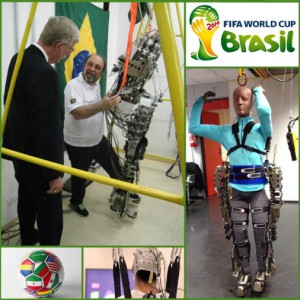What scientists say about the exoskeleton kick
by Beth
We got so many comments and likes to Ben Trockman’s post last week that I thought you blog readers might like a follow-up. Here’s how scientists reacted to that momentous event at the World Cup’s opening ceremonies — a teenager who is paralyzed used a thought-controlled, robotic exoskeleton to do an opening kick.
Wired magazine quoted a neuroscientist and biomedical engineer at the University of Michigan saying that the opening kick might just be grandstanding. For brain-machine interface researchers, the Wired story said, “the impressiveness of the demo depends largely on the degree to which the exoskeleton is controlled by the person’s brain.” My husband Mike Knezovich wrote a story years ago about similar research at the University of Chicago, and the Wired story says that while several exoskeletons that can allow a paralyzed person to walk slowly are already available, researchers have only had modest success starting and stopping exoskeletons with signals from the brain. The neuroscientist said that if the teenager had walked gracefully at a normal speed to the ball and made adjustments on the fly — like if the ball had moved just as he was about to kick it — that would have been a phenomenal advance.
Over at the NIH Director’s blog, Dr. Francis Collins described the opening kick as an inspiring event that he hopes will provide encouragement for people living with paralysis, including an estimated 6 million in the United States alone. He wants people to be realistic though. From the article:
As compelling as today’s demonstration may have been, it was just a proof of concept. Robotic exoskeletons remain in the very earliest stages of development. Scientists need to refine their designs and test them on more people, and they need to analyze and publish the enormous amount of data they’ve already gathered.
Dr. Collins was pleased that billions of people saw that opening kick and says he hopes it serves as an “inspiring glimpse of just one of the many things that can be achieved when science is supported over the long haul.” Last week’s dramatic debut of this robotic exoskeleton came from 20+ years of scientific studies, and in his post last week, Ben said “To know there are people in this world that have the drive and determination to cure paralysis and improve the lives of people with disabilities is incredible.”
I asked Ben to write that post last week because I wanted to know what the opening ceremony kick would mean to him personally. I wondered if he thought all the hype was just a gimmick — more spectacle than science. He answered my question with the last line of his post: “I know there are some who think that the effort might be promising too much, too soon, but leave no second guessing here — I’m in!”








June 30th, 2014 at 12:44 pm
Thanks for a thought-provoking post, Beth. While it is true that exoskeletons will not, any time soon, provide functional ambulation to the masses, there are some very positive impacts of ambulation for people with mobility impairments. Weight-bearing increases bone mass, stimulates bowel function and activates deeper muscle and sensory neurons that can only be reached with real muscle exertion. of course, it doesn’t take an exoskeleton to accomplish this, something like Lite Gate can act similarly.
I think what is important to note is that real innovation takes time. If you consider that Edison tried to make a light bulb over 1,000 times before he got it right, well, we have a ways to go with exoskeletons. But each iteration teaches us something new, gets us closer to the end goal. So while this technology is not within reach for most people with disabilities, and the functionality of it is questionable, it is, indeed, inspiring and leads us to dream of a day when a person with paralysis can walk up and kick a ball with physical grace. Ben’s words show us that they already do with with the grace of aspiration.